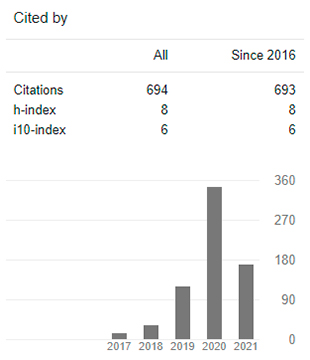Power and Robustness in Normality Tests with Montecarlo Simulation
DOI:
https://doi.org/10.29394/Scientific.issn.2542-2987.2020.5.18.5.108-119Keywords:
Montecarlo simulation, power, sturdiness, normality testsAbstract
The general objective of this research was to examine the power and robustness of normality tests in large and small samples, generated with Monte Carlo simulation. Non-parametric hypothesis tests were applied to measure the degree of discrepancy between the empirical distributions and the normal cumulative distribution function, which analyze the correlation between the theoretical and experimental distribution and those that are supported by the study of asymmetry and kurtosis. The comparison was made in two groups with different sample sizes. In large samples, the Kolmogorov-Smirnov tests were compared; Pearson's Chi-Square; Jarque-Bera and Geary; in the small samples Shapiro-Wilk; Cramér-von Mises; Lilliefors and Watson. The contrasts were carried out with the RStudio computer program and the rejection criterion for the null hypotheses was made through the p-value. In conclusion, the most robust test in large samples is Kolmogorov, estimating that its probability is less than 0.11. In small samples this result corresponds to Shapiro-Wilk with an estimate of less than 0.14. Regarding the power in the normality tests for large samples, it was shown that the most powerful of them is the Jarque Bera test, with a confidence interval between 0.86 and 1. For small samples, none of the tests under study it turned out powerful.
Downloads
References
Arshad, M., Rasool, M., & Ahmad, M. (2003). Anderson Darling and Modified Anderson Darling Tests for Generalized Pareto Distribution. Journal of Applied Sciences, 3(2), 85-88, e-ISSN: 1812-5662. Recovered from: https://dx.doi.org/10.3923/jas.2003.85.88
Bradley, J. (1978). Robustness?. British Journal of Mathematical and Statistical Psychology, 31, 144-152, e-ISSN: 0007-1102. Recovered from: https://doi.org/10.1111/j.2044-8317.1978.tb00581.x
Cabrera, G., Zanazzi, J., Zanazzi, J. & Boaglio, L. (2017). Comparación de potencias en pruebas estadísticas de normalidad, con datos escasos. Revista Facultad de Ciencias Exactas, Físicas y Naturales, 4(2), 47-52, e-ISSN: 2362-2539. Recuperado de: https://revistas.unc.edu.ar/index.php/FCEFyN/article/view/16775
Hurtado, F. (2020). Fundamentos Metodológicos de la Investigación: El Génesis del Nuevo Conocimiento. Revista Scientific, 5(16), 99-119, e-ISSN: 2542-2987. Recuperado de: https://doi.org/10.29394/Scientific.issn.2542-2987.2020.5.16.5.99-119
Islam, T. (2011). Normality Testing- A New Direction. International Journal of Business and Social Science, 2(3), 115-118, e-ISSN: 2219-6021. Recovered from: http://www.ijbssnet.com/journal/index/169
Downloads
Published
How to Cite
Issue
Section
License
The content of the journals of this site, are under a Creative Commons Attribution-Noncommercial-Share Alike 4.0 International License.













